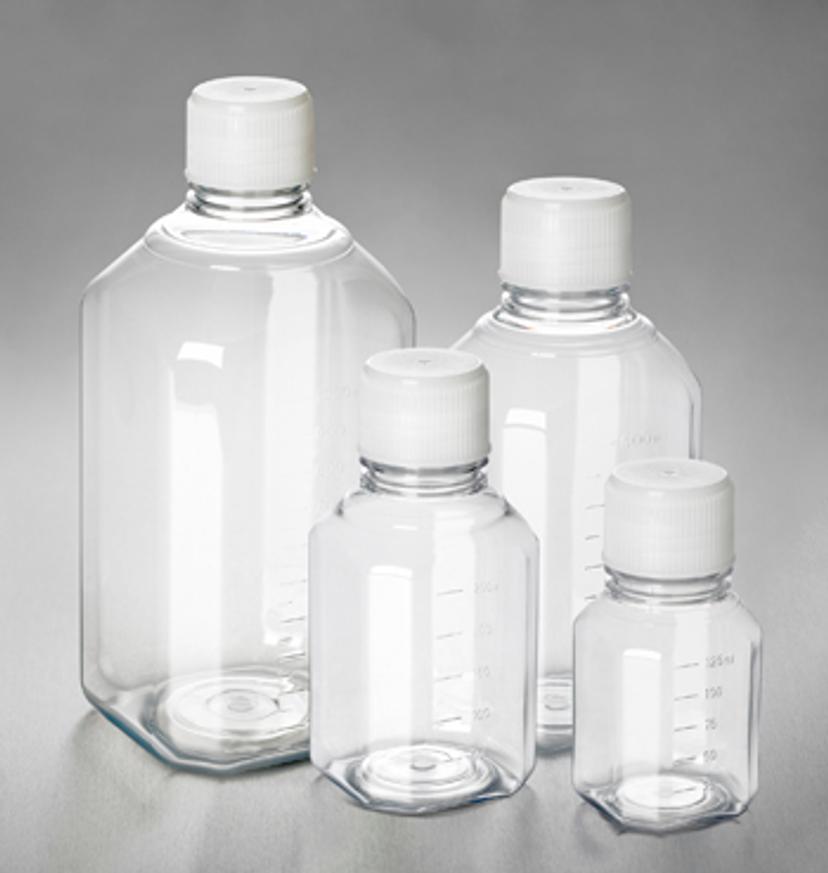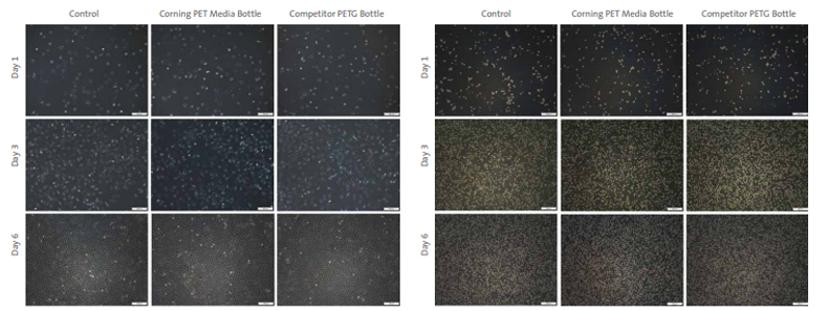Innovative, unbreakable & leak-proof PET media bottles
Here’s what you should know when choosing the best bottles for your cell culture experiment
9 Dec 2020

Biological and chemical reagents must be properly stored to maintain their purity and integrity of composition. Any decrease in purity can result in contamination and subsequently lead to inaccurate experiments and unusable data. When it comes to storing media or sera for cell culture applications, both polyethylene terephthalate (PET) and polyethylene terephthalate glycol (PETG) come highly recommended. Whilst often grouped together and rather similar in name, PETG is advertised to improve upon the already vaunted break-resistance of PET. Does this claim stack up, and how can you make the best decision for your cell culture storage needs?
To meet the growing demand for aqueous solution storage, Corning offers a wide range of its newest PET media bottles. The PET resin used in its manufacturing makes the bottle lightweight, break-resistant, and as transparent as glass. The bottles themselves meet the highest USP Class VI standards, hence certified noncytotoxic and nonhemolytic. Easy to handle and highly ergonomic, they offer an efficient alternative to glass thanks to the reduced long-term maintenance and replacement costs.
New leak-proof caps
When first introduced to the PET media bottle, the most visually notable feature is the incorporation of Corning’s newest and most innovative HDPE cap. Validated against IATA Packing Instruction 650 standards, they are designed to provide exceptional leak proofing compared to the traditional caps often found on other PETG bottles. The leak-proof nature of Corning’s HDPE caps allows the bottle to be fit for air shipments, once again highlighting their versatility.
Learn more about Corning PET media bottles in this short video >>
Go as cold as you need
Corning PET media bottles features
- Available in four sizes: 125 mL, 250 mL, 500 mL, and 1,000 mL
- Packaged in convenient, shrink-wrapped trays within an outer bag to ensure cleanliness
- Bottles have a sterility assurance level (SAL) of 10-6
- Molded graduations for accurate measurements
The robustness of PET means that it is often utilized across a wide range of temperatures. In the case of Corning PET media bottles, these can routinely withstand temperature levels as low as -40°C. For longer reagent and buffer solution storage needs, this figure can even drop to -70°C. As well as low temperature differentials, these robust bottles are resistant to high internal pressures of up to 95kPa. In a comparison study by Corning, the PET media bottles were measured against competitor PETG bottles for storage of serum at -80°C for 30 days. No physical change in the PET bottles was observed, and the subsequent performances of each separate serum in cell culture were found to be identical. The observations readily showcase the high-end resilience of PET media bottles to pressure and temperature differentials that rival PETG.

No more breaking bottles
One of the main benefits of switching to polymer resins from glassware was their resistance to shattering, which could often pose a safety risk in the laboratory, in addition to incurring otherwise avoidable maintenance costs. Both PET and PETG offer this inherent durability in their physical properties, however, the introduction of PETG was purported to further reduce any brittleness in PET by rendering the bottle softer and more pliable. In a separate study by Corning, the mechanical performances of PET octagonal bottles and PETG square bottles were compared by storing sample cell culture solutions within them at -70°C, then -40°C for 48 hours each. The bottles were afterwards dropped onto a steel surface from a fixed height of 910 mm (35.8 inches) with a Landmont drop tester, and they were visually assessed. Results of the study showed once more that both products demonstrated highly comparable mechanical performances and that PET remains a suitable break-resistant alternative to other materials.
No failure or leakage was observed after drop testing frozen Corning PET octagonal bottles
Meeting your cell culture needs
Resilient whilst retaining glass-like properties, PET and PETG paved the way for the rise in popularity of alternative storage bottles to glass. The creation of PETG was an attempt to further reduce brittleness in the resin, but for all intents and purposes, the results shown in the studies above conclude that PET matches PETG for performance. Break-resistant, built for high and low temperature and pressure differentials as well as topped off with a leak-proof screw cap, Corning PET media bottles promises to tick every box for your cell culture application needs.
Do you use Corning products in your lab? Write a review today for your chance to win a $400 Amazon gift card>>
